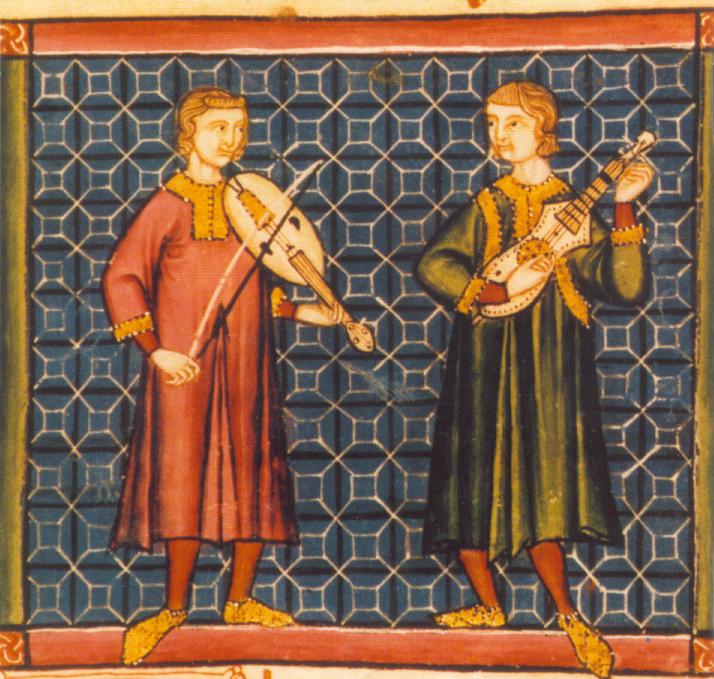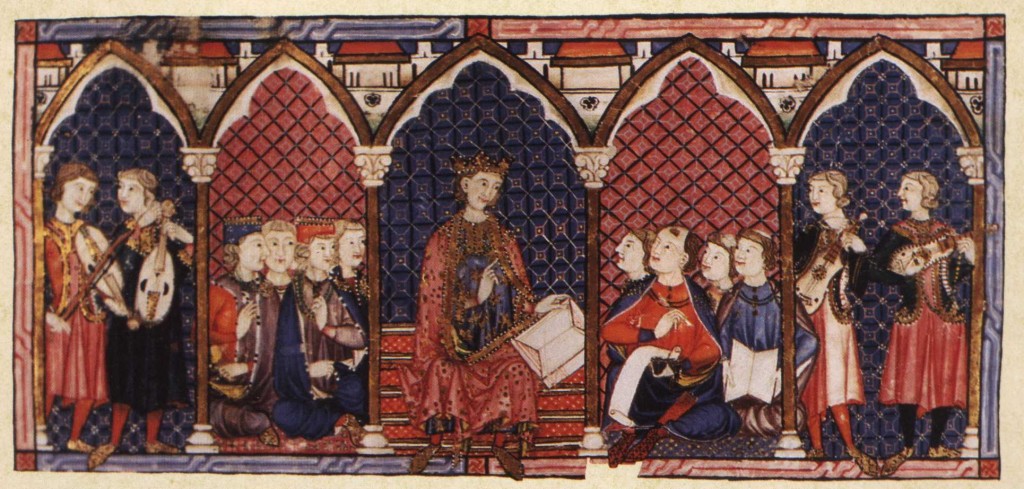ANARCHIES OF THE FLESH
The troubadour epoch was the twelfth century and they both extolled existing values and created new ones in song and verse. For a lady’s husband to become actively jealous was considered both doltish and dishonorable, a breach of the spirit of courtesy. Yet the record suggests that this was a fairly common occurrence and one of the occupational hazards of being a troubadour. The most famous ”crime passionel” of the epoch was the murder of Guilhem de Cabestanh , a troubadour knight whose love for he lady Seremonda aroused the jealousy of her husband, Raimon de Castel-Rousillon. The story goes that Raimon killed Guilhem while he was out hunting, removed the heart from the body, and had it served to his wife for dinner, cooked and seasoned with pepper.
It doesn’t matter that the story is probably apocryphal and that the grisly details were borrowed from an ancient legend, though Guilhem may well have died a violent death;it was enough that the Middle Ages believed it and drew the intended moral conclusion, that husbands should leave well enough alone. Raimon was held up to scorn while Guilhem became one of the great heroes of the troubadour epoch. His song ”Li Dous Cossire”, reportedly addressed to Seremonda, achieved immense posthumous fame. Ford Madox Ford gives us a translation of it in his literary ramblings through Provence:
That pleaseant fever/That love doth often bring/Lady, doth ever/Attune the songs I sing/Where I endeavour/To catch again your chaste/Sweet body’s savour/I crave but may not taste
The rules and requisites of courtly love are all duly set down in a manual entitles ”Flos amoris” or ”Ars amatoria”, produced by one Andreas Capellanus, or Andrew the Chaplain, about 1200. His system is as complex as the Nude Auditions Code, and for the same reason. It represents an effort to bring a certain order to the anarchies of the flesh.Among his thirty-one rules of conduct are the following:

In this miniature from the Cantigas, King Alfonso the Wise is portrayed as a youthful patron of the arts. We see musicians whose songs are probably being taken down by the seated scribes.
1.)Marriage cannot be pleaded as an excuse for refusing to love. 2.)A person who is not jealous cannot love. 3.) None can love two at once. There is no reason however, why a woman should not be loved by two men, or a man by two woman. 4.) It is love’s way always to increase or lessen. 14.) Easy winning makes love despicable; the difficult is held dear. 20.) The lover is always fearful. 28.) A slight presumption in the lover awakens the co-lover’s suspicion.
It was no more than an elaborate charade, but it worked for well over a century because the troubadours managed to make it interesting. ”There was unspeakable boredom in the castles,” Ezra Pound said. ”The chivalric singing was devised to lighten the boredom.” They sang, talked , and argued interminably about the fine points of courtly love, often in rhymed dialogue-debates known as ”tensions”.
The lord of a castle could consider himself fortunate when the troubadours came to his great hall to sing the praises of his wife. Aside from the sheer entertainment value, it was a matter of prestige and public relations, for songs had enormous currency in a world without newspapers. The Limousin troubadour Gaucelm Faidit, for instance, extolled the beauty of Jordana d’Ebreun so effectively that ”no valiant man of Vienne or of all Provence thought himself worth a straw unless he had seen her.”This sort of social asset could work to her husband’s advantage when it came time to forge alliances.
Money was scarce and the great nobles rewarded their poets with payment in kind if they needed it; horses, armor, or feudal privileges. Perdigon, a fisherman’s son who ” knew right well to viol, and to make poetry and to sing”, was knighted by the Dauphin of Auvergne and received ”land and revenues”. For a fisherman’s son to be knighted as a poet was no more remarkable than for a New York ghetto rapper to acquire a pink Bentley. Theoretically, the troubadour poet was supposed to be a belted knight, but in practice, despite the two dozen reigning princes whose names are on the list, he tended to come from the middle or lower classes. It was a democratic and egalitarian an institution as anything the Middle Ages could produce.

''Two excellent, thorough websites devoted to this Galician cycle of 420 devotional songs composed at the Court of King Alfonso X of Castile in the second half of the 13th century: The Oxford Cantigas de Santa Maria database Cantigas de Santa Maria at the SCA Minstrels page ''
The many ”vidas” , or troubadour biographies , that have come down to us in manuscript present an astonishingly broad section of feudal society. Bernart de Ventadorn was the son of a castle servant ” who gathered brushwood for the heating of the oven wherein was baked the castle’s bread”. Elias Cairel was trained as a goldsmith. Raimbault de Vaqueiras was the son of a poor Provencal knight ” who passed for mad”. Guilhem Figueira was a tailor’s son from Toulouse, and Peire Vidal the son of a furrier. Gaubertz de Poicebot became a monk as a boy and then ”for desire of woman he went forth from the monastery.”
Many of the most important troubadours becan their careers as jongleurs, professional entertainers, singing other people’s songs, and then went on to become recognized composers in their own right. The distinction between a jongleur and a troubadour was social as well as occupational. The jongleur figured in the company of clowns, mountebanks, and tightrope walkers; he was a lineal descendant of the classical Roman jesters. Though he might specialize in singing and playing instruments, he was well advised to cultivate more than one string to his viol. This could include knife throwing, chair balancing, gymnastics, magic and the paranormal.
Songs of another sort, topical, which had nothing to do with love, belonged to the category of ”sirventes” and fell under the general category of news and public affairs. Their purpose was frankly humorous, didactic, or polemical. In its simplest form the ”Sirvente” is an editorial harangue on current events. ” If a poor man robs a bedsheet, he’s called a thief and bows his head, but if a rich man robs a treasure, he is honored in the court…If some beggar robs a bridle, he’ll be hung by a man who’s robbed a horse.”
Bertran de Born was a clever manipulator of ”sirventes” as a propaganda weapon an was one of the great warmongering poets of the epoch. Apparently he loved war he loved both for its own sake , the way an actor loves the theatre; to Bertran the panoply of war is the logical climax of political life. His ”sirventes” almost make a convincing case for the notion that war in the twelfth century was a great aesthetic experience, a suitable enterprise for poets, for Bertran was not only a dashing sportsman but also a very graphic and meticulous reporter.
I Love to see the press of shields/with their hues of red and blue/of ensigns and banners/manycolored in the wind/and the sights of tents and rich pavilions pitched/lances shattered, shields pierced,shining/helmets split, and blows exchanged in battle
He wrote glowingly about the ”joyful season” of war, when knights appear on the scene, catapults are fired, and walls tumble; when one sees field strewn with bodies and hears the scream of riderless horses; when many a man goes to his rest with a long spear growing out of his chest.


